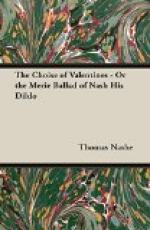Nothing is known of Postlethwayt and Price, who at one time owned the Rawlinson copy, that throws light on its source. In the Petyt, however, we get a suppositional explanation of its manifestly purer text. Petyt, subsequent to his call to the Bar, in 1670, was for many years Keeper of the Records in the Tower of London. Now we know that Lord Essex, an intimate friend and connection of the Earl of Southampton, and like Southampton a generous and discerning patron of letters, was for some time in the “free custody” of the Lord Keeper of the Tower. Further, Southampton, who had joined Essex in his rebellion, had been tried and convicted with his friend, and though the Queen spared his life, he was not released from the Tower until the ascension of James I. It is not unlikely, therefore, that a copy of Nash’s manuscript made for Lord Essex passed, on the execution of the latter, with other papers and documents, into the official custody of the Lord Keeper, to be subsequently unearthed by his successor, Petyt, who, with a taste for the “curious,” had it copied for his own edification. This supposition is further borne out as follows: The particular commonplace book in which this poem occurs has been written by various hands. In the same handwriting as, and immediately preceding “The Choise of Valentines,” are two poetical effusions dedicated “To the Earl of Essex,” both apparently written when he was in prison and under sentence of death. The other contents of the volume are likewise contemporaneous.
All things considered, then, the Petyt text, although transcribed about fifty years later, has weightier claims to attention than the version in the Rawlinson MSS. I have, therefore, adopted the former as a basis, giving the Rawlinson variations in the form of notes. A few of these are obviously better readings than those of the Petyt text: the reader cannot fail to distinguish these. In the main, however, the Inner Temple version will be found consistent with its particular dedication, whilst the Rawlinson variations appear due to an attempt, signally unsuccessful, to adapt the poem for general use.
For the rest I have faithfully adhered to the original in the basic text, and in the variorum readings, except in one particular. The Rawlinson MS. is altogether guiltless of punctuation, while the Petyt copy has been carelessly “stopped” by the scribe: I have therefore given modern punctuation.
J. S. F.
FOOTNOTES
[a] See page x. [Transcriber’s note: starting “It is curious to note”]
[b] Have with you to Saffron Walden, iii., 44.
[c] Terrors of the Night.




